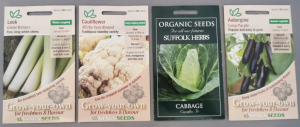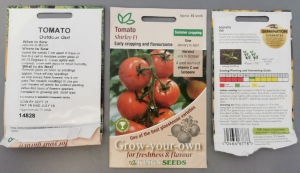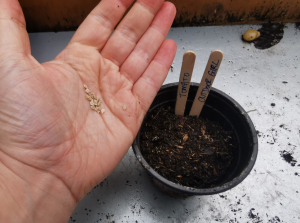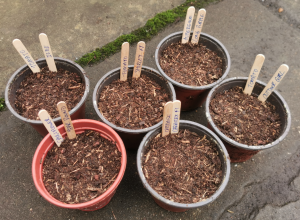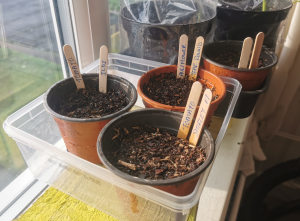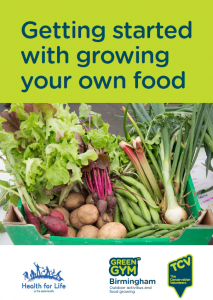
Introduction:
Welcome to our new blog series! This year, we are going to post monthly blogs with loads of information about what to sow during that month, indoors and out, or what you can directly sow outside, and later, what you could be harvesting in that month.
Although it is still winter, January is a great time to start lots of food plants. You can start these in a greenhouse, polytunnel, cold frame, or inside on a windowsill. If you start them indoors, make sure you put a tray, bowl, or plate under the pot to catch any water!
If you are new to growing your own food and want to have a go, why not start this year? Email us for a free PDF guide to help you! Laura will also help via social media or email – laura.hamilton@tcv.org.uk
What You’ll Need:
- Seeds!
- Plant labels – I use lollipop craft sticks from Poundland, but you can also cut up empty clean milk bottles into strips and use that
- A marker pen to write on the labels
- Peat free compost
- Plant pots
- A protective cover – greenhouse, polytunnel, plastic bags over pots, or folding plastic food trays (eat the pastry first!). You could also use a stackable clear plastic box with the lid on
- A drip tray if indoors – plate, bowl, drip tray, plastic fruit punnet (without holes), and plastic bags also work
Choose Your Location:
A south facing room or window will be the hottest place in the house and get most direct sunlight, but any space will do. I have a mini plastic greenhouse in the garden which is north facing, but the greenhouse gets most of the sunlight each day. I also fully utilise every windowsill available!
Seeds to Sow In January:
I have used seeds from my collection to inform these articles so the varieties named here are just suggestions. If you have other packets of aubergine for example, look on the back to see when you can sow them. Most seeds can be started indoors in January.
- Aubergine – long purple
- Cauliflower – all the year round
- Cabbage – caraflex F1
- Leek – giant winter
- Tomatoes – all varieties
How to Do It:
Half fill the pot with peat free compost. Open the packet of seeds and sow them into the pot. A 10cm pot can take 10 seeds scattered on the surface of the compost – you will thin them out and pot them up later. This means you can have one pot of aubergine, one pot of tomato, one pot of cauliflower, one pot of leek, and one pot of cabbage.
Remember to write and put a label in each pot! Gently cover the seeds over with more compost, water so they are damp but not soaked, and then pop each pot into wherever you are growing them (greenhouse, plastic box, windowsill etc). Indoor pots can be covered with a plastic bag/cling film to make individual greenhouses.
Keep an eye on the pots to make sure they don’t dry out, but don’t soak them either. The seeds should start to germinate after about a week, you can keep the covers over the pots to help them grow. You might need to rotate the pots so the plants grow straight (they will bend to find the sun!)
Harvesting Food in January:
There are some food crops ready to harvest in January if you have already started growing, or are returning to this article in 2022 and beyond (hello!).
- Leek – giant winter – sow in 2021 and harvest in 2022
- Kale – scarlet – pick the leaves off that you want to use and keep the rest on the plant to grow some more
- Sprouts – twist and pull the sprouts off, starting at the bottom of the stem. Pick them when they are around 3cm across.
- Swede – gently dig them up and clean them off. The leaves can be used in stir fry or bubble & squeak.
Remember to tag us and share pictures with us on social media – find us on:
And if you want help and advice, why not join our Grow Well, Eat Well group on Facebook? –
Don’t forget to claim your free guide via email, and happy growing!
